Bulbs
Flower Basics
Flower Beds & Specialty Gardens
Flower Garden
Garden Furniture
Garden Gnomes
Garden Seeds
Garden Sheds
Garden Statues
Garden Tools & Supplies
Gardening Basics
Green & Organic
Groundcovers & Vines
Growing Annuals
Growing Basil
Growing Beans
Growing Berries
Growing Blueberries
Growing Cactus
Growing Corn
Growing Cotton
Growing Edibles
Growing Flowers
Growing Garlic
Growing Grapes
Growing Grass
Growing Herbs
Growing Jasmine
Growing Mint
Growing Mushrooms
Orchids
Growing Peanuts
Growing Perennials
Growing Plants
Growing Rosemary
Growing Roses
Growing Strawberries
Growing Sunflowers
Growing Thyme
Growing Tomatoes
Growing Tulips
Growing Vegetables
Herb Basics
Herb Garden
Indoor Growing
Landscaping Basics
Landscaping Patios
Landscaping Plants
Landscaping Shrubs
Landscaping Trees
Landscaping Walks & Pathways
Lawn Basics
Lawn Maintenance
Lawn Mowers
Lawn Ornaments
Lawn Planting
Lawn Tools
Outdoor Growing
Overall Landscape Planning
Pests, Weeds & Problems
Plant Basics
Rock Garden
Rose Garden
Shrubs
Soil
Specialty Gardens
Trees
Vegetable Garden
Yard Maintenance
How to Grow Beanstalks
How to Grow Beanstalks. If your children love the story "Jack and the Beanstalk," give them a fun and educational weekend by growing your own beanstalks. Pole beans are among the most foolproof of plants for beginning gardeners. The seeds are large enough for even toddler hands to deal with, and they grow so quickly that children won't...

If your children love the story "Jack and the Beanstalk," give them a fun and educational weekend by growing your own beanstalks. Pole beans are among the most foolproof of plants for beginning gardeners. The seeds are large enough for even toddler hands to deal with, and they grow so quickly that children won't get bored waiting for something to happen in the garden. Choose a sunny day after the frost has passed and plant your very own fairy-tale props.
Things You'll Need
Trowel
Compost
Pole bean seeds
Study your yard to find a place that gets full sun at least 6 hours a day. Choose a spot up against a fence.
Dig a hole 6 inches deep for each beanstalk you plan to grow. Place the hole about 6 inches away from the fence. Make each hole about 6 inches across.
Shovel in one trowel of compost. Fill the hole back up with soil until it's within 1 inch of its original height. Have your child place two bean seeds on top of the dirt in the hole.
Demonstrate to your child how to cover the bean seeds with the remaining inch of dirt, patting down the soil with the back of the trowel. Continue digging and planting holes all along the fence until you have the desired size of bean crop planted.
Water the seeds thoroughly and keep them watered throughout the season. Beans need about 1 inch of water per week to grow well, so supplement rain showers with water from a hose or sprinkler.
Watch the beans grow until they have two sets of true leaves. Choose the stronger of each pair to keep and pinch off the weaker one at the surface. This will ensure that the nutrients go to the plant with the best chance of making lots of beans.
Pick beans from your beanstalks when they are solidly filled but before they get lumpy with large seeds inside.
Tips & Warnings
Plant green beans, wax beans and purple beans for a colorful variety of beanstalk crops. All these plants grow in the same way and need the same care.